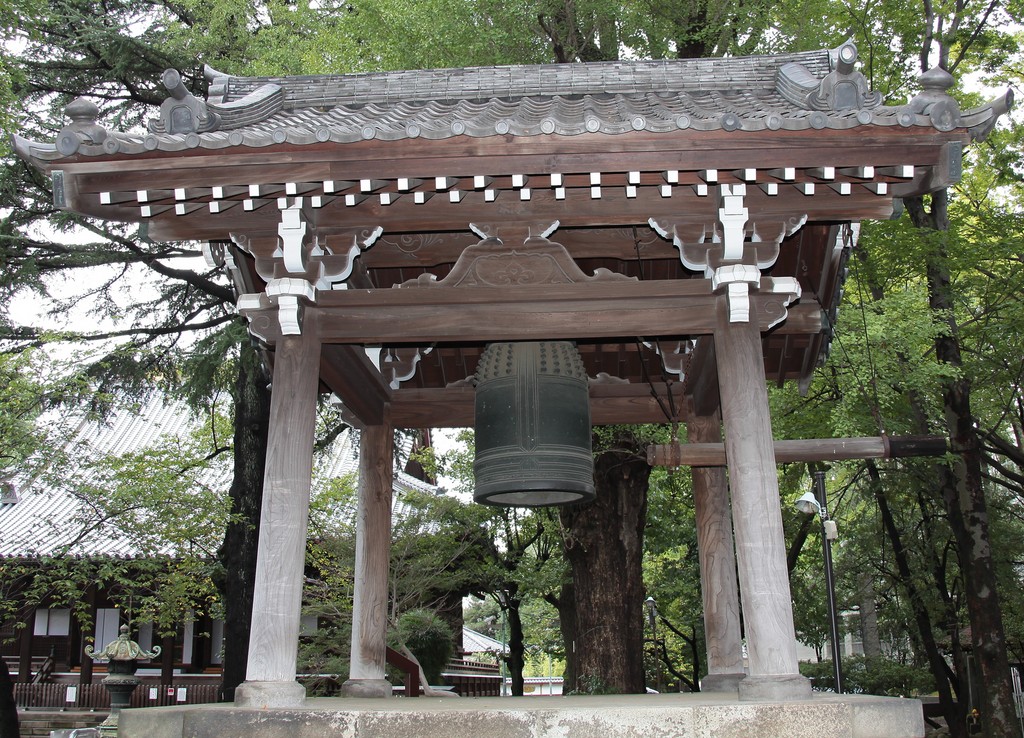CLOCHE EN BRONZE KAN-EIJI TEMPLE
Présente dans tous les temples bouddhiste, elles résonnent tous les matins et tous les soirs. Elles sonnent tous les ans pour la nouvelle année. 108 coups retentissent afin d'effacer les 108 tourments de l'homme (l’avidité, la colère, l’ignorance...)
Tōeizan Kan'ei-ji Endon-in (東叡山寛永寺円頓院, peut aussi s’écrire Kan'eiji, voire Kaneiji) était un temple bouddhiste Tendai fondé en 1625 par Tenkai à Tokyo au Japon, à proximité de l'actuel parc d'Ueno et de la gare d'Uguisudani. Le nom du temple lui vient de l'ère Kan’ei durant laquelle il fut érigé. Le principal objet d’adoration était le Yakushirurikō Nyorai (薬師瑠璃光如来). Parce qu’il était l’un des deux bodaiji (菩提寺, soit temple bodhi, un temple funéraire) du clan Tokugawa — l’autre étant Zōjō-ji — et parce qu’il fut détruit dans les derniers jours de leur règne, son nom est inextricablement lié au shogunat Tokugawa.
----------------------------------------------
Copper Bell (Cultural Asset of Taito City)
The Buuilder of the bell, Shiina Yoshihiro a caster in Edo, who was actives during the latter half ot the 17th century, and lived in Kandanabe-cho. There are 17 examples of his works, chiefly belles built between 1673 and 1686. Since many of them are related to Zojo-Ji and Kan'ei-ji temples, he is thought to have had a deep relationship with the Tokugawa Shogunate.
Tōeizan Kan'ei-ji Endon'in (東叡山寛永寺円頓院) (also spelled Kan'eiji or Kaneiji) is a Tendai Buddhist temple in Tokyo, Japan, founded in 1625 by Tenkai. The main object of worship is Yakushirurikō Nyorai (薬師瑠璃光如来). Because it was one of the two Tokugawa bodaiji (funeral temple; the other was Zōjō-ji) and because it was destroyed in the closing days of the war that put an end to the Tokugawa shogunate, its name is inextricably linked to that of the Tokugawa shoguns. Named after the Kan'ei era during which it was erected, this great complex used to occupy the entire heights north and east of Shinobazu Pond and the plains where Ueno Station now stands. It used to have immense wealth, power and prestige, and it consisted of over 30 buildings. Of the 15 Tokugawa shōguns, six are buried here. The Shinobazu Pond itself and the Bentendō temple which stands on its island used to be an integral part of Kan'eiji. Tenkai, liking Lake Biwa, had Benten Island built in imitation of Chikubushima, and then the Bentendō on it. At the time the island was accessible only by boat, but later a stone bridge was added on the east, making it possible to walk to it. The temple was destroyed during World War II, and the present one is just a reconstruction.
Tōeizan Kan'ei-ji Endon-in (東叡山寛永寺円頓院, peut aussi s’écrire Kan'eiji, voire Kaneiji) était un temple bouddhiste Tendai fondé en 1625 par Tenkai à Tokyo au Japon, à proximité de l'actuel parc d'Ueno et de la gare d'Uguisudani. Le nom du temple lui vient de l'ère Kan’ei durant laquelle il fut érigé. Le principal objet d’adoration était le Yakushirurikō Nyorai (薬師瑠璃光如来). Parce qu’il était l’un des deux bodaiji (菩提寺, soit temple bodhi, un temple funéraire) du clan Tokugawa — l’autre étant Zōjō-ji — et parce qu’il fut détruit dans les derniers jours de leur règne, son nom est inextricablement lié au shogunat Tokugawa.
----------------------------------------------
Copper Bell (Cultural Asset of Taito City)
This Copper bell "(Bronze Bell)" has a total height of 450 inches and a diameter at its widest point of 233 inches. It was donated and placed in the bell tower in front of the Genyuin Mausoleum for the 4th Shogun Tokugawa Ietsuna on May 8th in 1681, marking the first anniversary of his death. It is said to have been transferred to Kan'ei-ji temple's main hall to be its bell after the Meiji Restoration.
The Buuilder of the bell, Shiina Yoshihiro a caster in Edo, who was actives during the latter half ot the 17th century, and lived in Kandanabe-cho. There are 17 examples of his works, chiefly belles built between 1673 and 1686. Since many of them are related to Zojo-Ji and Kan'ei-ji temples, he is thought to have had a deep relationship with the Tokugawa Shogunate.
Tōeizan Kan'ei-ji Endon'in (東叡山寛永寺円頓院) (also spelled Kan'eiji or Kaneiji) is a Tendai Buddhist temple in Tokyo, Japan, founded in 1625 by Tenkai. The main object of worship is Yakushirurikō Nyorai (薬師瑠璃光如来). Because it was one of the two Tokugawa bodaiji (funeral temple; the other was Zōjō-ji) and because it was destroyed in the closing days of the war that put an end to the Tokugawa shogunate, its name is inextricably linked to that of the Tokugawa shoguns. Named after the Kan'ei era during which it was erected, this great complex used to occupy the entire heights north and east of Shinobazu Pond and the plains where Ueno Station now stands. It used to have immense wealth, power and prestige, and it consisted of over 30 buildings. Of the 15 Tokugawa shōguns, six are buried here. The Shinobazu Pond itself and the Bentendō temple which stands on its island used to be an integral part of Kan'eiji. Tenkai, liking Lake Biwa, had Benten Island built in imitation of Chikubushima, and then the Bentendō on it. At the time the island was accessible only by boat, but later a stone bridge was added on the east, making it possible to walk to it. The temple was destroyed during World War II, and the present one is just a reconstruction.
The temple and its numerous annexes were almost completely destroyed during the Boshin War's Battle of Ueno and never restored. The site where it once stood was confiscated and is presently occupied by Ueno Park. What is today the temple's main hall was taken from Kita-in in Kawagoe (Saitama Prefecture) and transferred to the site of a former Kan'ei-ji subtemple.
Many temple structures had already been destroyed in the great Mereiki fire of 1657. A new hall was constructed inside the enclosure of Kan'ei-ji in 1698.
